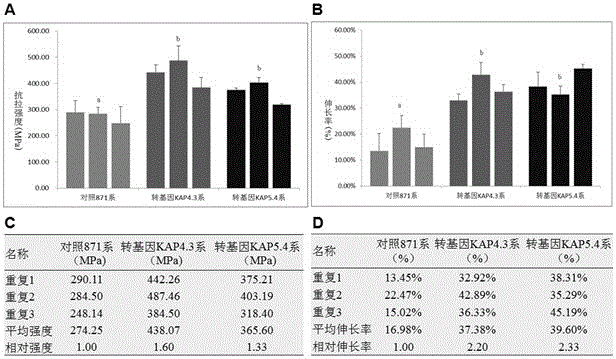Application of sheep KAP gene in mechanical property improvement and dyeing property improvement of natural silk, and recombinant expression vector of the KAP gene
A technology for expressing vectors and mechanical properties, applied in the direction of plant gene improvement, using vectors to introduce foreign genetic material, applications, etc., can solve problems such as the gap in comprehensive performance, achieve strong mechanical properties, good dyeing performance, and overcome poor dyeing performance.
- Summary
- Abstract
- Description
- Claims
- Application Information
AI Technical Summary
Problems solved by technology
Method used
Image
Examples
Embodiment 1
[0024] 1. Sequence optimization of wool keratin-associated proteins (KAP)
[0025] According to the preference of endogenous gene expression sequence codons in the silkworm genome sequence data, the present invention is derived from sheep KAP Gene sequences (gene accession numbers: GI: 238637219 and GI: 57164397) were optimized and designed, and the optimized nucleotide sequences such as SEQ ID NO.1 and SEQ ID NO.2 were named KAP4.3 and KAP5.4, respectively. Its amino acid sequence is shown in SEQ ID NO.3 and SEQ ID NO.4.
[0026] 2. Construction of Bombyx mori transgene recombination vector
[0027] According to the requirements of the currently known and public transgenic technology based on piggyBac transposable vectors in silkworms, the silkworm transgenic recombinant vector pBac{3×P3-DsRed; FibH-KAP4.3-LBS} was constructed ( figure 1 A) and pBac{3×P3-DsRed; FibH-KAP5.4-LBS} ( figure 1 B). Its detailed preparation method is as follows: the artificially synthesized KAP...
Embodiment 2
[0029]The commercial diapause silkworm strain 871 was used as the raw material, and the parental silkworm eggs were treated with low-temperature acceleration at 16°C to relieve the diapause of the offspring silkworm eggs; then 10-15 nL of the recombinant vector pBac{3×P3 -DsRed; FibH-KAP4.3-LBS} and the helper plasmid pHA3PIG were injected into 247 G0 silkworm eggs released from diapause, sealed with non-toxic glue and placed in an environment at 25°C and 85% relative humidity Incubating in the middle of greening, 177 G0 generation silkworms were hatched, and then the silkworms were raised with mulberry leaves until they turned into moths, and 36 G0 generation silkworms were obtained, and a total of 22 circles of G1 generation silkworms were obtained by backcrossing or selfing the obtained silkworm moths The eggs were observed with an Olympus? motorized macroscopic fluorescence microscope, and one moth circle emitting red fluorescence was obtained after screening, and a total o...
Embodiment 3
[0031] The commercial diapause silkworm strain 871 was used as the raw material, and the parental silkworm eggs were treated with low-temperature acceleration at 16°C to relieve the diapause of the offspring silkworm eggs; The mixture of DsRed; ibH-KAP5.4-LBS} and the helper plasmid pHA3PIG was injected into 234 G0 silkworm eggs released from diapause, sealed with non-toxic glue and placed in an environment at 25°C and 85% relative humidity Accelerate the hatching and hatch to obtain 126 G0 generation silkworms, and then raise the silkworms with mulberry leaves until they become moths, and obtain 17 G0 generation silkworm moths, and obtain 10 rounds of G1 generation silkworm eggs by backcrossing or selfing the obtained silkworm moths , observed with an Olympus? motorized macroscopic fluorescent microscope, and obtained 1 red fluorescent moth circle after screening, and obtained 6 positive transgenic silkworms with red fluorescent eyes, and the transformation efficiency was 4.5%...
PUM
 Login to View More
Login to View More Abstract
Description
Claims
Application Information
 Login to View More
Login to View More - R&D
- Intellectual Property
- Life Sciences
- Materials
- Tech Scout
- Unparalleled Data Quality
- Higher Quality Content
- 60% Fewer Hallucinations
Browse by: Latest US Patents, China's latest patents, Technical Efficacy Thesaurus, Application Domain, Technology Topic, Popular Technical Reports.
© 2025 PatSnap. All rights reserved.Legal|Privacy policy|Modern Slavery Act Transparency Statement|Sitemap|About US| Contact US: help@patsnap.com



